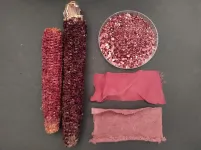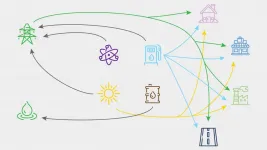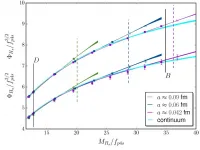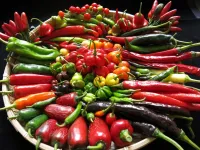Waste from making purple corn chips yields a natural dye, supplements, kitty litter
2021-03-24
(Press-News.org) The more colorful a food, the more nutritious it probably is. For example, purple corn contains compounds associated with a reduced risk of developing diabetes and heart disease. The cobs contain the same compounds but are typically thrown out. Now, researchers report a step-wise biorefinery approach in ACS Sustainable Chemistry & Engineering that uses the whole cob, producing a dye and a possible nutraceutical with the pigments, and an animal litter with the left-overs.
Eating a rainbow of fruits and vegetables provides a variety of health benefits, with vitamins and nutrients stored within the plant's color-producing compounds. One group of compounds contributing distinct hues to food are anthocyanins -- vibrant pigments desired as natural dyes that also have antioxidant and anti-inflammatory properties. Anthocyanins are found in purple corn's kernels and the corncobs, which are typically discarded. Past attempts at repurposing cobs have involved harmful and expensive solvents to extract compounds. Water could be used as an eco-friendly and cost-effective agent for this process, but it is not very efficient. And then the insoluble cob material is still left over as waste. So, Fabrizio Adani, Roberto Pilu, Patrizia De Nisi and colleagues wanted to extract beneficial pigments from purple corncobs with a multi-step approach to make many value-added products, while also closing the loop with zero waste at the end.
The researchers devised a biorefinery approach to extract anthocyanins from a new variety of purple corn they developed. First, ground-up corncobs and water were mixed and heated, removing 36% of the pigments compared to methods with acetone and ethanol solvents. The pigments from this step were used to dye cotton and wool fabrics. In the next step of the biorefinery method, the researchers removed an additional 33% of the anthocyanin content from the water-treated cobs with an ethanol mixture. These extracts showed antioxidant activity and anti-inflammatory properties in cells in petri dishes and could be used in the future to develop nutraceutical supplements, the researchers say. Finally, the team found that the remaining insoluble purple grounds were similar to commercial corncob animal litter. In tests, the residual cob material was even more absorbent than the commercial product. And because the material still contains anthocyanins, which have antimicrobial activity, the purple litter could fight bacteria and reduce odors, the researchers say. Used purple corn cob litter could also be composted along with other organic matter, resulting in no waste, they explain.
INFORMATION:
For more of the latest research news, register for our upcoming meeting, ACS Spring 2021. Journalists and public information officers are encouraged to apply for complimentary press registration by emailing us at newsroom@acs.org.
The authors acknowledge funding from Fondazione Cariplo.
The American Chemical Society (ACS) is a nonprofit organization chartered by the U.S. Congress. ACS' mission is to advance the broader chemistry enterprise and its practitioners for the benefit of Earth and all its people. The Society is a global leader in promoting excellence in science education and providing access to chemistry-related information and research through its multiple research solutions, peer-reviewed journals, scientific conferences, eBooks and weekly news periodical Chemical & Engineering News. ACS journals are among the most cited, most trusted and most read within the scientific literature; however, ACS itself does not conduct chemical research. As a specialist in scientific information solutions (including SciFinder® and STN®), its CAS division powers global research, discovery and innovation. ACS' main offices are in Washington, D.C., and Columbus, Ohio.
To automatically receive news releases from the American Chemical Society, contact newsroom@acs.org.
Follow us: Twitter | Facebook
[Attachments] See images for this press release:

ELSE PRESS RELEASES FROM THIS DATE:
2021-03-24
Since the early industrial revolution in the mid-1700s, fossil fuels have acquired an ever-growing footprint in energy production. However, the environmental concerns of fossil fuels use and their inevitable depletion have led to a global shift toward renewable energy sources. These transitions, however, raise questions about the best choice of renewables and the impact of investing in these resources on consumer cost.
In a recent study published in the journal Nature Communications, researchers at Texas A&M University have devised a metric that reflects the average price of energy in ...
2021-03-24
The unprecedented rainfall from Hurricane Harvey in 2017 brought more than flood damage to southeast Texas. For people living in environmental justice communities such as the Manchester neighborhood near the Houston Ship Channel, heavy rainfall and flooding may have increased risks of exposure to harmful chemicals from nearby industry.
To gain a better understanding of how flooding mobilized pollution in the area, a research team led by Garett Sansom, DrPH, research assistant professor in the Department of Environmental and Occupational Health at the Texas A&M University School of ...
2021-03-24
umans are remarkably adaptable, and our ancestors have survived challenges like the changing climate in the past. Now, research is providing insight into how people who lived over 5,000 years ago managed to adapt.
Madelynn von Baeyer Ph.D. '18, now at the Max Planck Institute for the Science of Human History, UConn Associate Professor of Anthropology Alexia Smith, and Professor Sharon Steadman from The State University of New York College at Cortland recently published a paper in the Journal of Archaeological Science: Reports looking at how people living in what is now Turkey adapted agricultural practices to survive as conditions became more arid.
The work was conducted ...
2021-03-24
March 24, 2021 - With heavy workloads and high professional and personal demands, medical residents in training - and those in urology residency programs - face a high risk of burnout. At one urology department, a wellness program designed by and for residents produced meaningful reductions in burnout risks, reports a study in Urology Practice®, an Official Journal of the American Urological Association (AUA). The journal is published in the Lippincott portfolio by Wolters Kluwer.
The Resident Wellness Curriculum (RWC) in the Scott Department of Urology at Baylor College of Medicine, Houston, led to significant improvements in key aspects of burnout, according to the new research by Jennifer M. Taylor, MD, and colleagues. ...
2021-03-24
Researchers at the Perelman School of Medicine at the University of Pennsylvania have produced a detailed molecular atlas of lung development, which is expected to be a fundamental reference in future studies of mammalian biology and of new treatments for diseases, such as COVID-19, that affect the lungs.
The researchers, who published their study in Science, generated a broad atlas of cell types in the developing and adult mouse lung by measuring the expression of genes in thousands of individual mouse lung cells across the lifespan, covering multiple cell types and ...
2021-03-24
Bone turnover markers, and specifically bone resorption markers, are commonly used to monitor patients' response to pharmacological treatment and adherence.
In 2011, the Joint Committee on Bone Marker Standards of the International Osteoporosis Foundation (IOF) and the International Federation of Clinical Chemistry and Laboratory Medicine (IFCC) designated Procollagen type I N-propeptide (PINP) and the C-terminal telopeptide of type I collagen (ß-CTX) in blood as reference bone turnover markers for bone formation and bone resorption, respectively, in osteoporosis. ...
2021-03-24
Peer deeper into the heart of the atom than any microscope allows and scientists hypothesize that you will find a rich world of particles popping in and out of the vacuum, decaying into other particles, and adding to the weirdness of the visible world. These subatomic particles are governed by the quantum nature of the Universe and find tangible, physical form in experimental results.
Some subatomic particles were first discovered over a century ago with relatively simple experiments. More recently, however, the endeavor to understand these particles has spawned the largest, most ambitious and complex experiments in the world, including ...
2021-03-24
An international team of researchers has found that three commonly used antiviral and antimalarial drugs are effective in vitro at preventing replication of SARS-CoV-2, the virus that causes COVID-19. The work also underscores the necessity of testing compounds against multiple cell lines to rule out false negative results.
The team, which included researchers from North Carolina State University and Collaborations Pharmaceuticals, looked at three antiviral drugs that have proven effective against Ebola and the Marburg virus: tilorone, quinacrine and pyronaridine.
"We were looking for compounds that could block the entry of the virus into the cell," says Ana Puhl, senior scientist at Collaborations Pharmaceuticals and ...
2021-03-24
Scientists investigating the genetics of chilli pepper species have discovered a whole host of new chilli hybrids that can be grown by crossing domesticated peppers with their wild cousins. This will allow plant breeders to create new varieties that have better disease resistance and could increase productivity.
Despite their huge world-wide culinary appeal, chillies are relatively difficult to cultivate, being prone to disease and sensitive to growing conditions.
There are 35 species of pepper in the Capsicum family, including five domesticated species. The most well-known ...
2021-03-24
The process of fabricating materials is complicated, time-consuming and costly. Too much of one material, or too little, can create problems with the product, forcing the design process to begin again. Advancements in the design process are needed to reduce the cost and time it takes to produce materials with targeted properties.
Funded by the National Science Foundation (NSF), researchers at Texas A&M University are using advanced computational and machine-learning techniques to create a framework capable of optimizing the process of developing materials, cutting time and costs.
"Our general focus ...
LAST 30 PRESS RELEASES:
[Press-News.org] Waste from making purple corn chips yields a natural dye, supplements, kitty litter



